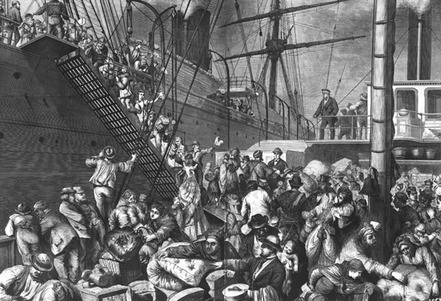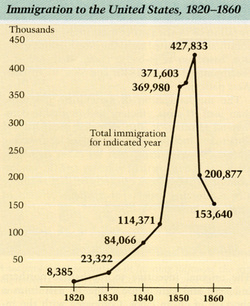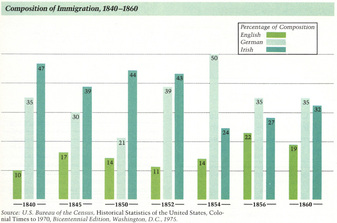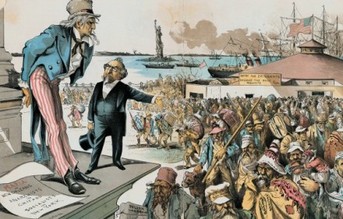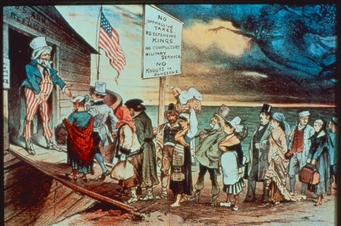Why Make the Journey?
Irish Immigration:
In the mid-1840s, Ireland suffered through the Irish Potato Famine (1845-1849). Because of the famine, hundreds of thousands of Irish people fled to America.
In the mid-1840s, Ireland suffered through the Irish Potato Famine (1845-1849). Because of the famine, hundreds of thousands of Irish people fled to America.
German Immigration:
After a series of failed rebellions in Europe in 1848, many Germans left their countries seeking political freedom. Most German peasants settled in the Midwest, particularly Wisconsin, Missouri, and Texas. German artisans and intellectuals settled in northern cities, such as New York, Chicago, and Milwaukee.
After a series of failed rebellions in Europe in 1848, many Germans left their countries seeking political freedom. Most German peasants settled in the Midwest, particularly Wisconsin, Missouri, and Texas. German artisans and intellectuals settled in northern cities, such as New York, Chicago, and Milwaukee.
The Immigrants
After living in America, many Irish immigrants became naturalized. This means that they applied for and were granted American citizenship. Once the settled, Irish immigrants settled to have their relatives join them. This made the Irish population greatly increase.
Many of the Irish immigrants were Jacksonian Democrats because the Democrats had reached out to them when they first arrived in America.
Because of these immigrants, America became a mosaic of different cultures. Immigrants brought traditional cultures with them.
Most of the immigrants, particularly the Irish, were Roman Catholic. Even though they were in America, they still followed Church traditions of their home countries.
These immigrants quickly picked up jobs worked long hours in tedious jobs. Immigration had a great effect on industry in America. As more and more people immigrated, more jobs were opened since so many people were looking for job opportunities. This means that more companies were made and the industry greatly improved.
Many of the Irish immigrants were Jacksonian Democrats because the Democrats had reached out to them when they first arrived in America.
Because of these immigrants, America became a mosaic of different cultures. Immigrants brought traditional cultures with them.
Most of the immigrants, particularly the Irish, were Roman Catholic. Even though they were in America, they still followed Church traditions of their home countries.
These immigrants quickly picked up jobs worked long hours in tedious jobs. Immigration had a great effect on industry in America. As more and more people immigrated, more jobs were opened since so many people were looking for job opportunities. This means that more companies were made and the industry greatly improved.
Hostility Towards Immigrants
Irish and German immigrants were often discriminated. Americans felt threatened by their presence because the newcomers had different cultures and religions. Also, Americans believed that they were the “Native Americans” because they were born in America and had lived there before the immigrants. However, they did not see the irony in that statement. Another irony is that it was the American ideal to welcome foreigners, since the country’s founding had been founded by immigrants.
Besides culture differences, Americans also felt threatened by the cheap labor of Irish immigrants. Because Irish immigrants were willing to work for lower wages, many companies used them to break strikes for higher wages and better working conditions. In the 1830s and 1840s, many mill girls lost their jobs to Irish men. This caused many Americans to resent the Irish because they thought that the Irish were "stealing" their jobs.
Besides culture differences, Americans also felt threatened by the cheap labor of Irish immigrants. Because Irish immigrants were willing to work for lower wages, many companies used them to break strikes for higher wages and better working conditions. In the 1830s and 1840s, many mill girls lost their jobs to Irish men. This caused many Americans to resent the Irish because they thought that the Irish were "stealing" their jobs.
Religious Issues
Religion created tension between immigrants and Americans. Protestants disapproved of the Catholic religion. They believed that Catholic's emphasis on rituals and on the Pope's authority discouraged individual thinking, which is something that Americans value highly. On the other hand, Catholics were angry when their children were forced to read the Protestant version of the Bible and learn Protestant values from Protestant textbooks. Also, since Catholics did not find drinking gambling, and sports as immoral, they fought to enact laws restricting these things.
Americans vs Immigrants
Tension between the Americans and the immigrants grew as more and more immigrants immigrated to America. Americans believed that the immigrants were stealing their jobs. Because of this tension, many immigrant opposing parties were formed. One of them was the American Party otherwise known as the Know-Nothing Party or the KKK. People who opposed to immigration were known as Nativists because they believed that they were the "native-born Americans".
In 1843, the American Republican Party was formed. This party pushed for a new naturalization law that stated that immigrants were required to live in the United States for 21 years before being eligible for citizenship. Then, when the Philadelphia school board allowed Catholic students to use Catholic textbooks, the American Republican Party protested.
In 1844, when American Republicans were attempting to vote in Philadelphia's Irish districts, they were attacked by Irish Catholics who saw them as irrational. In May 1844, riots that were aroused by the attacks, formed. Irish homes and churches were burned down, and 30 people were killed.
Even today, there are ambivalent views of immigration. Some people feel that the vast amount of people immigrating to America are going to take all their jobs and cause more problem for the people who already lived there. Others feel the ideal of America is to be welcoming to any foreigner. Here are some cartoons contrasting the two different reactions of immigration.
In 1843, the American Republican Party was formed. This party pushed for a new naturalization law that stated that immigrants were required to live in the United States for 21 years before being eligible for citizenship. Then, when the Philadelphia school board allowed Catholic students to use Catholic textbooks, the American Republican Party protested.
In 1844, when American Republicans were attempting to vote in Philadelphia's Irish districts, they were attacked by Irish Catholics who saw them as irrational. In May 1844, riots that were aroused by the attacks, formed. Irish homes and churches were burned down, and 30 people were killed.
Even today, there are ambivalent views of immigration. Some people feel that the vast amount of people immigrating to America are going to take all their jobs and cause more problem for the people who already lived there. Others feel the ideal of America is to be welcoming to any foreigner. Here are some cartoons contrasting the two different reactions of immigration.
Archbishop John Hughes
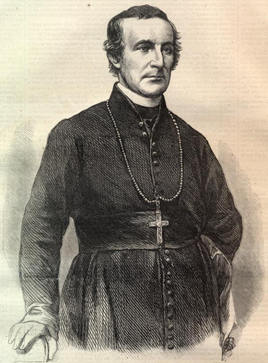
Archbishop John Hughes was the leader of the Catholic Church in New York. He helped immigrants by organizing defenses of churches from Nativist mobs who wanted to destroy them.
He was born in Ireland on June 24, 1797. In 1817, he left Ireland for America with his father and his brother. His family settled in Chambersbug, Pennsylvania. When he was in Ireland, Hughes had received some education, and he was really determined to become a priest. When he got to America, he met an Irish schoolmaster who encouraged him to attend Mount St. Mary's colleges in Emmitsburg, Maryland. Hughes decided to go, and he started out as a college's gardener to pay for his education. In 1826, he was ordained a priest.
Father Hughes responded to attacks against Catholicism with forceful essays and fiery debates. In 1838, he was appointed to the Archdiocese of New York and in 1842, he became bishop. Finally in in 1850, he became archbishop. Hughes was a born leader. He was patient and organized and never let his guard down. He was aware of threats against Catholicism, and he was never one to hide away. Under him, many Catholic churches and schools were built.
Interesting Facts:
The American Party was originally called the Know-Nothing Party because when members were asked about the organization, they were forced to reply "I know nothing".
President John F. Kennedy's roots can be traced back to Irish immigrants in Massachusetts.
The American Party was originally called the Know-Nothing Party because when members were asked about the organization, they were forced to reply "I know nothing".
President John F. Kennedy's roots can be traced back to Irish immigrants in Massachusetts.
